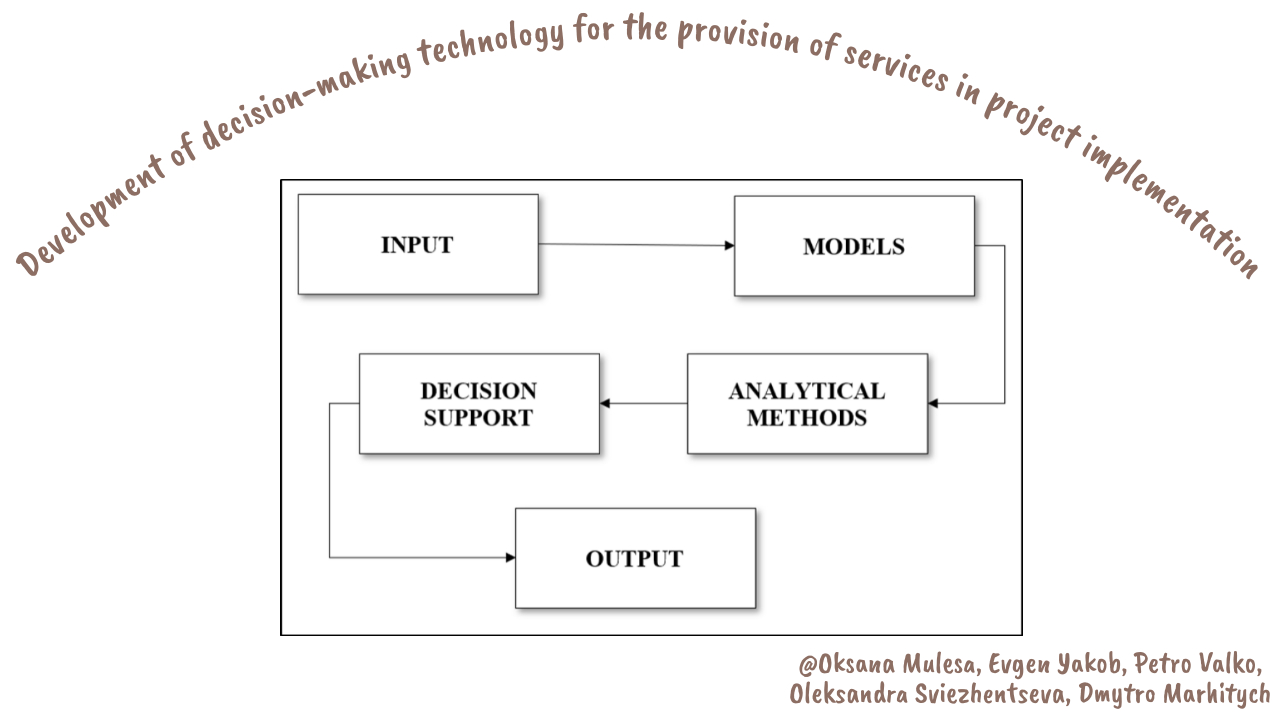Development of decision-making technology for the provision of services in project implementation
DOI:
https://doi.org/10.15587/2706-5448.2024.301317Keywords:
decision-making, linear programming problem, screening, service provision, cross-border project, service consumers, service providersAbstract
The object of research is decision-making processes regarding the provision of services within the framework of cross-border projects.
To achieve the aim of the research, an analysis of the service provision market was first conducted, its features have been revealed and problems arising in the processes of its functioning have been identified. The main problem is to find the optimal distribution of services between performers in the service management system. A mathematical model of the problem of single- and multi-criteria optimization has been developed, where the problem is decomposed into independent sub-problems. The problem is presented in the form of a linear programming problem. Various efficiency criteria of the found distributions are proposed. Depending on the number of criteria, the problem will be a single-criteria Boolean programming problem or a multi-criteria optimization problem. An iterative method for finding the optimal distribution of services has been created, and individual methods are laid out in the form of production rules, which is understandable and allows to gain new knowledge.
Based on the obtained data, a decision-making technology has been developed regarding the distribution of service consumers between performers. At the same time, decision-making methods were used, which allow optimizing the processes of service provision. A systematic approach was used when designing information technology. This made it possible to create an effective and problem-relevant technology that helps in making informed decisions about the distribution of services between participants of cross-border projects. A structural and functional diagram of the decision support system has been developed. Its structural elements are detailed.
The obtained results reflect a thorough analysis of the current state of the services market and the development of effective decision-making technology, which contributes to the optimization of work in the field of cross-border projects. This approach can be useful for various subjects involved in the implementation and coordination of international projects.
References
- Ranerup, A., Henriksen, H. Z. (2019). Value positions viewed through the lens of automated decision-making: The case of social services. Government Information Quarterly, 36 (4), 101377. doi: https://doi.org/10.1016/j.giq.2019.05.004
- Ranerup, A., Henriksen, H. Z. (2020). Digital Discretion: Unpacking Human and Technological Agency in Automated Decision Making in Sweden’s Social Services. Social Science Computer Review, 40 (2), 445–461. doi: https://doi.org/10.1177/0894439320980434
- Mulesa, O., Horvat, P., Radivilova, T., Sabadosh, V., Baranovskyi, O., Duran, S. (2023). Design of mechanisms for ensuring the execution of tasks in project planning. Eastern-European Journal of Enterprise Technologies, 2 (4 (122)), 16–22. doi: https://doi.org/10.15587/1729-4061.2023.277585
- Xu, H., Kuchansky, A., Biloshchytska, S., Tsiutsiura, M. (2021). A Conceptual Research Model for the Partner Selection Problem. 2021 IEEE International Conference on Smart Information Systems and Technologies (SIST). doi: https://doi.org/10.1109/sist50301.2021.9465931
- Nazarkevych, H., Tsmots, I., Nazarkevych, M., Oleksiv, N., Tysliak, A., Faizulin, O. (2022). Research on the effectiveness of methods adaptive management of the enterprise’s goods sales using machine learning methods. 2022 IEEE 17th International Conference on Computer Sciences and Information Technologies (CSIT). Lviv, 539–542. doi: https://doi.org/10.1109/csit56902.2022.10000447
- Teslyuk, V., Batyuk, A., Voityshyn, V. (2022). Method of Recommending a Scrum Team Composition for Intermediate Estimation of Software Development Projects. 2022 IEEE 17th International Conference on Computer Sciences and Information Technologies (CSIT). doi: https://doi.org/10.1109/csit56902.2022.10000432
- Ogryczak, W. (2000). Multiple criteria linear programming model for portfolio selection. Annals of Operations Research, 97 (1), 143–162. doi: https://doi.org/10.1023/a:1018980308807
- Mulesa, O., Melnyk, O., Horvat, P., Tokar, M., Peresoliak, V., Kumar, H. (2023). Modeling of Decision-Making Processes in the Service Management System. 2023 IEEE 18th International Conference on Computer Science and Information Technologies (CSIT). doi: https://doi.org/10.1109/csit61576.2023.10324217
- Thaher, T., Chantar, H., Too, J., Mafarja, M., Turabieh, H., Houssein, E. H. (2022). Boolean Particle Swarm Optimization with various Evolutionary Population Dynamics approaches for feature selection problems. Expert Systems with Applications, 195, 116550. doi: https://doi.org/10.1016/j.eswa.2022.116550
- Syan, C. S., Ramsoobag, G. (2019). Maintenance applications of multi-criteria optimization: A review. Reliability Engineering & System Safety, 190, 106520. doi: https://doi.org/10.1016/j.ress.2019.106520

Downloads
Published
How to Cite
Issue
Section
License
Copyright (c) 2024 Oksana Mulesa, Evgen Yakob, Petro Valko, Oleksandra Sviezhentseva, Dmytro Marhitych

This work is licensed under a Creative Commons Attribution 4.0 International License.
The consolidation and conditions for the transfer of copyright (identification of authorship) is carried out in the License Agreement. In particular, the authors reserve the right to the authorship of their manuscript and transfer the first publication of this work to the journal under the terms of the Creative Commons CC BY license. At the same time, they have the right to conclude on their own additional agreements concerning the non-exclusive distribution of the work in the form in which it was published by this journal, but provided that the link to the first publication of the article in this journal is preserved.







